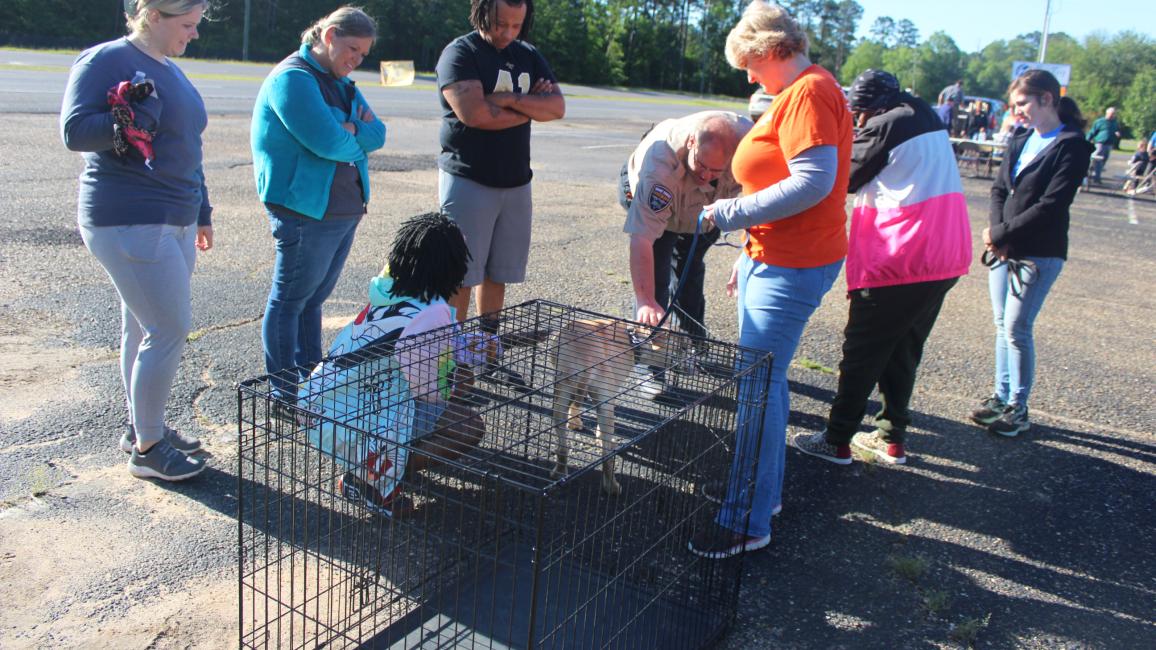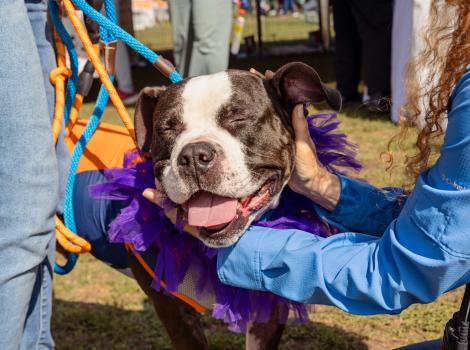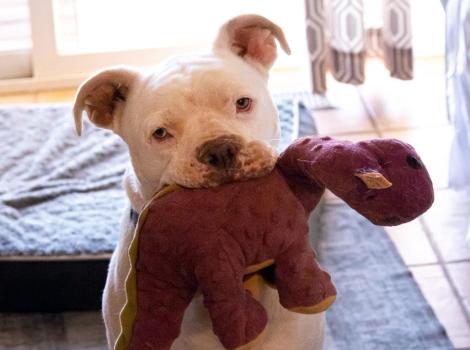How animal services officers are saving more pets

Sheriff Steven McCain is a busy man. Not only is he the chief law enforcement officer for Grant Parish in central Louisiana, but he’s also the detention center warden, ex-officio tax collector, head of emergency preparedness, and de facto chief of animal control.
On this particular Saturday morning, the out-of-uniform sheriff is all in for the animals. Hunched over an outdoor griddle in the town of Bentley, he’s flipping pancakes for nearly 100 people at a pet adoption event called Pancakes and Puppies. The event is a rousing success, and all the puppies are quickly adopted.
In an era where 63% of all animals entering shelters are strays, the work of animal services officers ― even those with multiple responsibilities like the sheriff ― is front and center. And helping these officers do their part to reduce the number of animals entering shelters and save more lives is one of Best Friends’ strategies to support shelters reaching no-kill by 2025.
“If more than half of your intake is from one source, it only makes sense to concentrate on that,” says Scott Giacoppo, Best Friends director of national shelter support.
Since 2017, Best Friends has conducted nearly 300 training sessions (both virtual and in person) around the country, reaching more than 7,500 people. “In our workshops and training sessions on community-based animal services, we’re able to show how shelters can reduce the number of animals coming into the shelter, increase their save rates, and ultimately get to no-kill,” Scott says.

Helping animal services officers help their communities
With help from Best Friends, Hesperia (California) Animal Services has improved how animal services officers interact with residents. Instead of spending large amounts of time writing citations and bringing animals straight to the shelter, the officers work directly with pets’ families to solve problems in the field.
“When we became involved with Best Friends (in) about 2018, we were reviewing our processes,” says Osbaldo Montes, a Hesperia Animal Services employee. “Scott came out, spent time with us, and rode along with our officers. He spoke our language.”
Best Friends training has led Hesperia animal services officers to alter their old practice of picking up animals and automatically taking them to the shelter. Instead, they practice “return-to-home.” Rather than taking an animal straight to the shelter, officers first try to find out where an animal lives and, if possible, take the animal home. Officers get to know their neighborhoods and create more personal relationships with pets’ families.
In addition to hands-on training with officers, Best Friends equipped Hesperia trucks with microchip scanners so that pets with IDs can be identified and taken home. In the absence of a microchip, officers knock on doors to find out where a pet lives. Using this community relations-based approach, over time officers learn where certain pets reside and even learn their names.

Going the extra mile to get Dallas home
Return-to-home was front and center recently for Hesperia officers when Dallas, a black-and-tan pup, got loose while his family was packing to move. Days later, officers picked him up in the desert outside of town. Using a microchip scanner provided by Best Friends, they were able to identify Dallas.
“We traced him to his now-vacant home,” says Osbaldo. “We then checked with the water department, traced the former homeowner’s name, and got a phone number. The family had moved about a 25-minute drive away. We contacted the owner and delivered the dog home to be reunited with his family.”
[Lifesaving soars with new shelter practices]
It’s just one example of a new way of working with residents and their pets. “If we return an escaped animal, we will walk the property line with pet owners to see if any fencing is in disrepair or if there’s a place where the dog might be digging holes,” says Osbaldo. “Our officers also carry pet care kits in their trucks that include basic tools and repair materials. You spend half an hour making a repair, and you stop a dog from getting out. It takes time to do these things, but we find it really pays off.”
“Hesperia completely embraced this new model of animal services, and in no time at all they were successful,” says Scott. “Everyone there knew what they wanted for the animals. They are all kind and compassionate people. They just didn’t have a blueprint. Once they saw how it could be done, they embraced it as a united team.”

Embracing change in Grant Parish
When Steven (who flipped pancakes at the pet adoption event) arrived as sheriff of Grant Parish, Louisiana, in 2011, the parish had no animal services or shelter. Starting from scratch, he eventually spearheaded the building of a small animal shelter and the implementation of basic animal welfare protocols.
“Our mission initially was to pick up stray animals, including animals that were causing complaints,” the sheriff says. “And then we got paid a cold call visit from Best Friends, an organization that I had never heard of. We met for about an hour, and they told us all the great things they could help us with. It all sounded too good to be true.”
Grant Parish embraced a satellite foster program and other recommendations and assistance from Best Friends.
[Animal shelters work smarter to save more lives]
Scott traveled to the shelter to work with the two animal services officers. Among the many topics he covered were return-to-home and using good community relations to solve animal issues in the field.
“It was about helping them make a mindset change to try new things,” Scott says, “and then being able to show them how these new things were working.”
With only two deputies to cover the 640 square miles of Grant Parish, the office also uses social media to improve communication with the public. Officers post photographs of stray dogs not yet returned to their families. There’s no charge for picking up an animal.
To counteract what the sheriff calls “a natural negative perception that sometimes persists about animal control and law enforcement,” Grant Parish is planning to reach out to children in the community by distributing free coloring books. “Scott introduced us to a nonprofit that provides them,” the sheriff says. “We hope that by directly connecting with children, we can begin to change that perception.”

Getting down to basics in Pine Bluff
Marcus Graydon, director of animal control in Pine Bluff, Arkansas, remembers when his animal services officers had a lot more to do than what was in their basic job descriptions. “Everyone did everything,” says Marcus. “The animal control officers helped to clean the facility and feed the animals. Then they answered the telephone. I began visiting other shelters to see how they do things.”
In addition to helping Pine Bluff with basic animal care, Nick Walton, Best Friends senior manager of national shelter support, worked with Marcus and the staff to be more selective on how and when animals from nonemergency cases would be brought to the shelter. More emphasis would be placed on assisting people who, while facing challenges, still wanted to keep their pets.
“Best Friends also helped us with the resources to return animals directly to their owners,” says Marcus. “We know more about animals and where they live in the community. We are working toward printing signs and placing them door to door when animals are found.”

More education, fewer citations
Pine Bluff is making an effort to help residents solve their own pet issues, and when possible they avoid issuing citations. Marcus says the staff tries to educate the public on every call that comes in. And if people don’t understand what they need to do to have their animal be in compliance with the city, the staff tries to bring them up to speed.
“Education is key here,” Marcus says. “If we see an ordinance that’s not being followed, we write them an order to correct (the situation), and we’ll set up a time to come back and see if things are corrected. We know this sometimes takes time. So if we come back and see residents making progress to correct a situation, we give them more time.”
Teaching animal services officers to solve more problems in the field and thus reduce animal intake is just one of the ways Best Friends is helping shelters move closer to no-kill by 2025. As a result, officers in Hesperia, Grant Parish, Pine Bluff, and many other communities around the country are implementing best practices that make it possible to bring more pets straight home and then keep them with their families.





